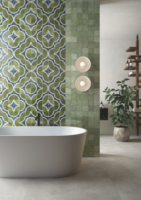Ceramic tile manufacturers, distributors, dealers and those involved in the sale and selection of construction materials have a new resource available to communicate the many benefits of choosing ceramic tile, particularly when health and safety are primary considerations.
Tile Council of North America (TCNA) produced a bulletin to provide at-a-glance information in response to increasing interest in the human health and safety aspects of various building materials, in both commercial and residential construction. "People are seeing media reports on formaldehyde in laminate flooring, and phthalates in the PVC in vinyl flooring, and are worried," said TCNA Executive Director, Eric Astrachan. "Just last week Dr. Oz did a segment on the potential toxicity of laminate flooring products. We don't know which products specifically are concerning, but what we do know, and what we want to help consumers understand, is that these concerns are simply non-issues when it comes to ceramic tile."
Specifically, the bulletin -- available at www.TCNAtile.com -- points to these health, safety and environmental aspects of ceramic tile:
- VOC, Formaldehyde and PVC-Free
- Hypoallergenic
- Made of natural ingredients
- Has a 60-year service life
- Non-flammable/zero smoke development
- Wide availability of slip-resistant options
Many of the listed attributes bring specification benefits for building design professionals. For example, because ceramic tile is non-flammable and does not produce smoke in a fire, it inherently meets the flame spread and smoke development requirements of Section 803 of the International Building Code (IBC) for interior wall and ceiling materials. Similarly, the durability of ceramic tile makes it cost-effective and the best choice for reducing negative environmental impacts when compared to flooring products that need to be replaced more frequently. And slip resistance is a top consideration for all spaces where people will walk on wet surfaces.
Homeowners and those selling in the residential market can also rely on the bulletin for solid, researched information to provide the peace of mind that comes from knowing unambiguously that ceramic tiles do not contain any of the chemicals that have been in the news associated with other flooring products.
The scientific community is only recently starting to assess background exposure levels and to better understand how much interior finishes can affect human health. More and more research is being done as people realize the long term impact of various common chemicals in the built environment," said Dr. Jyothi Rangineni, the TCNA research scientist who cited more than 30 sources to compose and validate the information in the bulletin. "Although it may look a little like marketing fluff because of its brevity, it's not. We drew all of the information only from peer-reviewed scientific journals and science- and research-based entities such as the CDC and others."
The brevity and accessibility of the bulletin is what makes it so "perfectly useful," according to Astrachan. "TCNA reviewed and summarized extensive research in this field, as well as CDC and EPA documents, to offer consumers and the construction industry a digestible version of current thinking and concerns," he said. For those who want to dig deeper, Astrachan noted, all of the sources from which the information was derived are listed on the reverse of the bulletin.
The release of the bulletin was announced by Astrachan on Tuesday, April 19, at TCNA's annual press conference at Coverings, the largest tile and stone trade fair and expo in the U.S., with exhibitors from more than 40 countries.



